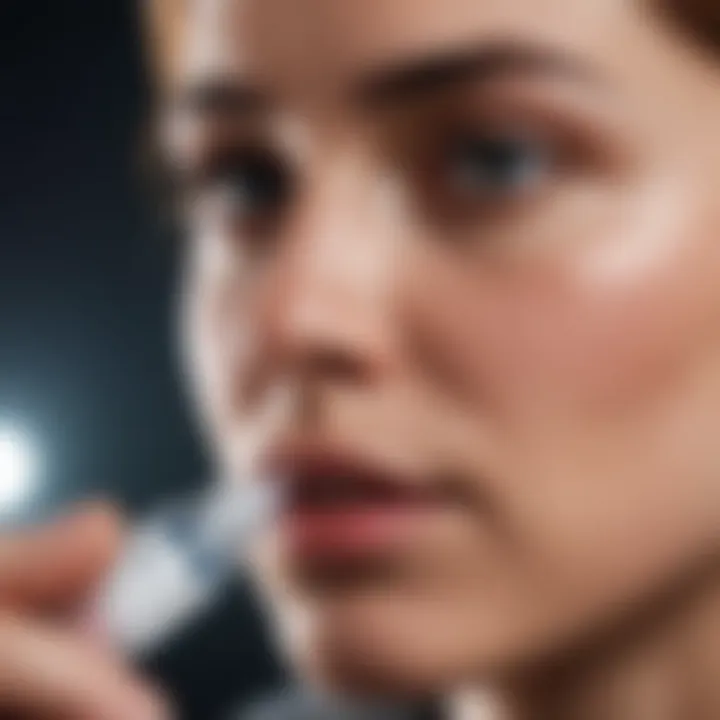Effective Techniques to Halt a Nosebleed and Prevent Recurrence


Wellness
Nosebleeds, medically known as epistaxis, can be a common yet alarming occurrence for many individuals. When faced with a sudden gush of blood from the nostrils, it's crucial to remain calm and act promptly. Understanding the causes of nosebleeds is the first step in effectively managing and preventing them. Factors such as dry air, nasal injuries, allergies, or underlying health conditions like high blood pressure can contribute to nosebleeds. By grasping these root causes, you can effectively tailor your approach to stopping nosebleeds promptly.
To efficiently address a nosebleed, positioning plays a significant role. While the instinct may be to tilt the head back, this can potentially lead to swallowing blood or inhaling it, causing further complications. Instead, experts recommend leaning slightly forward to prevent the blood from flowing back into the throat. Gently pinching the soft lower part of the nose, called the nasal septum, for about 10-15 minutes can often stem the bleeding. This pressure helps constrict the blood vessels, facilitating clot formation and stopping the nosebleed effectively.
When dealing with recurring nosebleeds or those lasting longer than 20 minutes, seeking medical attention is advisable. Persistent nosebleeds could indicate underlying health issues that require professional assessment. Additionally, incorporating humidity into your living or working environment can help prevent future nosebleeds, especially in dry climates or heated indoor settings. By exploring these practical strategies and understanding when to seek medical intervention, individuals can effectively manage and prevent nosebleeds, promoting overall well-being and peace of mind.
Understanding Nosebleeds
Understanding nosebleeds is crucial in managing and preventing this common medical condition. By grasping the underlying causes and risk factors, individuals can take proactive steps to address and potentially avoid nosebleeds altogether. This section serves as the foundation for the entire article, offering key insights that will guide readers through the subsequent steps of stopping a nosebleed effectively.
Causes of Nosebleeds
Dry air
Dry air stands out as a significant contributor to nosebleeds. Its low humidity levels can lead to nasal dryness, making the blood vessels more prone to rupturing and causing bleeding. In this context, the lack of moisture in the air becomes a pivotal aspect to address when exploring ways to prevent nosebleeds. While dry air may provide comfort in certain climates, its impact on nasal health cannot be overlooked.
Nose picking
Nose picking, although a common habit for some, can escalate into a cause of nosebleeds. The act of inserting fingers into the nasal passages can irritate the delicate linings, potentially resulting in bleeding episodes. Despite providing temporary relief or satisfaction, nose picking poses risks that can culminate in frequent nosebleeds. Highlighting the repercussions of this habit sheds light on the importance of nasal care practices.
Injury or trauma
Trauma or injury to the nose is a direct trigger for nosebleeds. Whether due to accidents, sports activities, or physical altercations, such occurrences can inflict damage to the nasal structures, leading to bleeding episodes. Recognizing the susceptibility of the nose to trauma underscores the significance of taking precautions to safeguard against potential injuries that may cause nosebleeds.


Risk Factors
Medical conditions
Certain medical conditions, such as hypertension or blood clotting disorders, can increase the likelihood of experiencing nosebleeds. The presence of these conditions heightens the fragility of nasal blood vessels, making them more susceptible to bleeding episodes. Understanding the correlation between medical health and nosebleeds is crucial in managing both the underlying condition and associated symptoms.
Medications
The consumption of certain medications, such as anticoagulants or nasal decongestants, can trigger nosebleeds as a side effect. These medications may interfere with the body's clotting mechanisms or cause nasal dryness, contributing to the onset of nosebleeds. Awareness of the potential impact of medications on nasal health enables individuals to make informed choices regarding their treatment options.
Environment
Environmental factors, including exposure to dry or polluted air, can exacerbate the risk of nosebleeds. Pollutants in the air can irritate the nasal passages, while dry air can compromise nasal moisture levels, both increasing the susceptibility to nosebleeds. Considering the influence of the surrounding environment on nasal health emphasizes the importance of creating optimal indoor conditions to prevent nosebleeds.
Immediate Steps to Stop a Nosebleed
Positioning
Sit up straight
Within the context of managing a nosebleed, the positioning of the body plays a vital role in minimizing blood flow. Sitting up straight is a fundamental step in controlling a nosebleed as it helps prevent blood from flowing rapidly down the throat. By adopting this posture, individuals can reduce the risk of ingesting blood, which could lead to discomfort or complications. The upright position aids in maintaining a clear airway, promoting better breathing, and ensuring a more controlled environment to address the nosebleed promptly.
Lean forward
Another essential aspect of managing a nosebleed is leaning forward. This posture encourages blood to flow out of the nostrils rather than down the throat. By leaning forward, individuals can facilitate the draining of blood, decreasing the likelihood of swallowing blood and potential gagging or choking. This inclination also assists in applying pressure to the nostrils effectively, aiding in the cessation of the bleeding. By emphasizing a forward-leaning position, individuals can take proactive measures to address the nosebleed efficiently.


Applying Pressure
Pinch the nostrils
Applying pressure to the nostrils is a critical step in controlling a nosebleed. By pinching the nostrils firmly, individuals can help stem the flow of blood from the blood vessels in the nose. This pressure promotes clotting, which is essential in stopping the bleeding. Pinching the nostrils also aids in directing the blood flow back into the circulation system rather than outward. It is a simple yet highly effective method for managing a nosebleed and should be done consistently until the bleeding subsides.
Ice Pack
Applying ice
Utilizing an ice pack is a supplementary step that can assist in managing a nosebleed. Applying ice to the bridge of the nose can constrict blood vessels, reducing blood flow and promoting clotting. The cold temperature helps in numbing the area, potentially providing relief for any discomfort associated with the nosebleed. However, it is essential to use the ice pack correctly, ensuring it is wrapped in a cloth to prevent direct contact with the skin. While ice packs can complement other techniques, they should be used in conjunction with pressure and proper positioning for optimal effectiveness.
Seeking Medical Attention
When dealing with a nosebleed, knowing when to seek medical attention is crucial. Recognizing the signs that indicate the need for professional help can prevent complications and ensure proper treatment. If the bleeding is persistent despite following first-aid measures or if it lasts for more than 20 minutes, seeking medical assistance is advisable. Moreover, individuals with underlying health conditions such as blood disorders or clotting issues should seek immediate medical attention to avoid any potential risks. Consulting a healthcare provider can help to address the root cause of the nosebleed and prevent future occurrences.
When to Seek Help
Persistent Bleeding
Persistent bleeding is a concerning issue that may indicate a serious underlying condition. When a nosebleed continues for an extended period, it can lead to excessive blood loss and potential complications. Recognizing the signs of persistent bleeding, such as continuous flow of blood even after applying pressure, is critical in determining the need for medical intervention. Seeking help promptly can ensure adequate treatment and prevent further health risks associated with prolonged bleeding.
Underlying Health Conditions
Underlying health conditions play a significant role in the occurrence and management of nosebleeds. Individuals with conditions like hypertension, liver disease, or blood clotting disorders are more prone to recurrent nosebleeds. Understanding the implications of these health issues on nosebleeds is essential for effective management. Recognizing the presence of underlying health conditions helps healthcare providers tailor treatment strategies to address the specific needs of each individual. By evaluating and managing these conditions, healthcare professionals can provide targeted interventions to prevent future nosebleeds and promote overall well-being.


Treatment Options
When traditional methods fail to stop a nosebleed, medical interventions may be necessary to address the underlying cause and prevent recurrence. Two common treatment options for severe or recurrent nosebleeds are cauterization and nasal packing.
Cauterization
Cauterization involves using a chemical or heat source to seal off the blood vessels causing the nosebleed. This procedure aims to stop the bleeding by creating a controlled burn or chemical reaction that promotes vessel closure. Cauterization is often recommended for persistent or severe nosebleeds that do not respond to conservative measures. While cauterization can effectively stop bleeding, there are potential risks such as tissue damage or scarring that need to be considered before undergoing the procedure.
Nasal Packing
Nasal packing is a technique where medical gauze or a specialized balloon is inserted into the nasal cavity to apply direct pressure on the bleeding vessels. This method helps to compress the blood vessels and promote clotting to stop the bleed. Nasal packing is commonly used for cases of recurrent or profuse nosebleeds that require additional intervention. However, nasal packing may cause discomfort and congestion for the individual and is typically removed after a few days once the bleeding has subsided. Understanding the benefits and drawbacks of nasal packing is essential in deciding the appropriate course of action for managing severe or persistent nosebleeds.
Preventing Future Nosebleeds
In this crucial section of the article, we delve into the significance of preventing future nosebleeds. By focusing on preventive measures, individuals can avoid the inconvenience and potential health risks associated with recurrent nosebleeds. Understanding the importance of maintaining nasal health and minimizing factors that contribute to nosebleeds is paramount. By implementing proactive strategies, such as improving air quality and adopting proper nasal care routines, individuals can significantly reduce the occurrence of nosebleeds.
Humidify the Air
Use a Humidifier
Exploring the use of a humidifier in preventing future nosebleeds is essential. A humidifier plays a vital role in maintaining optimal humidity levels in indoor environments, which is crucial for nasal health. By introducing moisture into the air, a humidifier helps prevent the nasal passages from drying out, reducing the risk of nosebleeds caused by dry air. The key characteristic of a humidifier lies in its ability to regulate humidity levels, creating a more comfortable and healthy environment. This device is a popular choice for individuals seeking to enhance air quality and alleviate respiratory issues. The unique feature of a humidifier is its capacity to disperse fine mist evenly, providing consistent humidification throughout the room. While the advantages of using a humidifier include improving nasal moisture levels and reducing susceptibility to nosebleeds, potential disadvantages may involve the need for regular maintenance and cleaning to prevent bacterial growth.
Nasal Care
Avoid Nose Picking
The practice of avoiding nose picking is fundamental in the prevention of future nosebleeds. Nose picking can damage the delicate blood vessels in the nasal passages, leading to bleeding episodes. By refraining from this habit, individuals can safeguard their nasal health and minimize the risk of traumatic nosebleeds. The key characteristic of avoiding nose picking is its role in maintaining nasal integrity and preventing unnecessary irritation. This practice is a beneficial choice for individuals aiming to prioritize nasal hygiene and prevent recurrent nosebleeds. The unique feature of avoiding nose picking is its simplicity yet profound impact on nasal health, ensuring overall well-being. While the advantages of abstaining from nose picking include reducing the likelihood of nosebleeds and promoting nasal health, a potential disadvantage could be the challenge of breaking the habit for some individuals.
Use Saline Sprays
Another essential aspect of nasal care is the use of saline sprays. These sprays contribute significantly to maintaining nasal moisture and clearing nasal passages, reducing the risk of nosebleeds. The key characteristic of saline sprays lies in their ability to hydrate the nasal mucosa and alleviate dryness, promoting healthy nasal function. Saline sprays are a popular choice for individuals seeking a gentle yet effective solution for nasal congestion and dryness. The unique feature of saline sprays is their natural composition, making them safe and suitable for long-term use. The advantages of using saline sprays include supporting nasal health and moisturizing the nasal passages, which can aid in preventing nosebleeds. However, individuals should be cautious of potential disadvantages such as mild irritation or discomfort that may arise from improper use.



